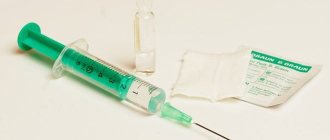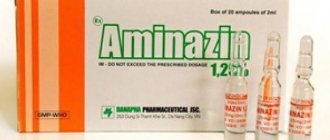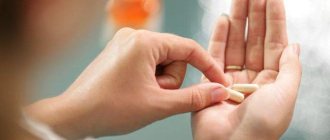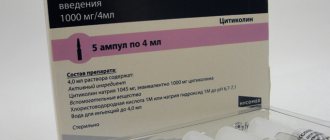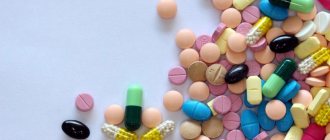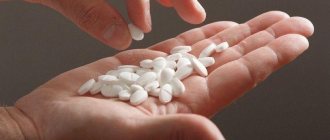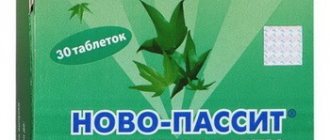Release form
The drug is available exclusively in the form of tablets of various dosages.
The concentration of the active substance in the drug can be 75 or 150 mg. Trittico is a trade patented name for a product produced by an Italian pharmaceutical company. The international name of the substance is trazodone. The active ingredient Trittico is trazodone hydrochloride with a concentration of 75 or 150 mg.
Among the auxiliary components:
- sucrose;
- povidone;
- magnesium stearate;
- wax.
Available in the form of biconvex oblong tablets, color - from white to yellow, with two lines on both sides. Extended-release tablets - this means that the drug is released gradually.
The tablets are dispensed by prescription, ten pieces in a blister. Trittico 75 mg - three blisters per package, 150 mg - two blisters per package.
Trittico analogues, price in pharmacies
If necessary, you can replace Trittiko with an analogue for therapeutic action - these are the following drugs:
- Phenibut;
- Glycised;
- Phenotropil;
- Piracetam;
- Pantogam.
When choosing analogues, it is important to understand that the instructions for use of Trittico, the price and reviews of drugs with similar effects do not apply. It is important to consult a doctor and not change the drug yourself.
Store in a dark place at a temperature not exceeding 25 ⁰C. Shelf life – 3 years. Sales in pharmacies with a doctor's prescription.
On prescription.
Antidepressant Trittico
Trittico tablets have a thymoleptic, muscle relaxant, mild sedative and anxiolytic effect. Due to the composition of the main substance, which is similar to the structure of serotonin receptors, the main pharmacological action is associated with the suppression of serotonin reuptake. The drug has no effect on the ability of neurons to capture dopamine and norepinephrine.
In addition to mental manifestations of anxiety states - increased irritability, fear, sleep disturbances - the use of the drug Trittico, according to the instructions, relieves somatic signs of developing depression, such as tachycardia, increased sweating, hyperventilation, frequent urge to urinate.
The medicine Trittiko helps restore libido and improve the quality of potency. Those suffering from alcohol dependence when taking the drug experience a decrease in craving for drinks containing ethanol. During the treatment of alcoholism, the medication effectively relieves withdrawal symptoms and the accompanying depressive disorder.
The drug is produced on the basis of a triazolopyridine derivative. It has an antidepressant effect, has a mild sedative effect, relieves symptoms of anxiety, fights sleep disorders, and evens out the general emotional background of a patient in a state of depression. Trazodone hydrochloride has no effect on the breakdown of monoamine oxidase compared to the active substances of tricyclic antidepressants.
According to the instructions for use, trazodone is absorbed by the gastrointestinal tract (mainly in the intestines), the maximum concentration of the substance occurs 1.5-2 hours after administration. If the drug is taken during or after a meal, the period of absorption and achievement of maximum plasma concentration increases. The binding of trazodone hydrochloride to blood plasma proteins reaches 89-95%, it easily penetrates into all liquids - saliva, breast milk, bile.
The properties described in the instructions for the drug Trittico determine its use in various forms of depressive conditions, in the complex treatment of alcoholism, and in the treatment of nervous system disorders. Indications for the use of an antidepressant are:
- somatogenic, psychotic, neurotic or endogenous depression;
- decreased libido and sexual activity;
- insomnia and other sleep disorders;
- appetite and eating disorders (bulimia, anorexia);
- increased fatigue, chronic fatigue syndrome;
- various phobias, obsessive states;
- dependence on benzodiazepine drugs.
Description of the drug
The tablets are white with a yellowish tint and have an oval shape. Each of them contains a strict amount (75 mg) of trazodone hydrochloride. Auxiliary components are: carnauba wax, magnesium stearate, sucrose, polyvinylpyrrolidone.
Pharmacists note that even with long-term use of this pharmacological drug, it is not addictive.
Trittico tablets are completely neutral in the uptake of norepinephrine and dopamine. Therefore, if you take the medicine, you don’t have to worry about weight gain.
Trittico drug:
- It has an active thymoleptic and anxiolytic effect on the patient’s body.
- Increases the depth and duration of patients' sleep during treatment
- Reduces pathological craving for ethanol and decreases when taken correctly.
- Eliminates anxiety and depression.
to contents ^
Pharmacological properties
Trazodone is a drug from the group of antidepressants that has several mechanisms of action on the central nervous system. There are centers in the brain that are responsible for the emotional sphere of human life. The neurons of these centers transmit information to each other using special substances - monoamines.
Depression is associated with decreased concentrations of monoamines in the brain. Serotonin metabolism influences mood to a greater extent. The mechanism of the main active ingredient trittiko is associated with both an increase in the amount of serotonin and an increase in its effect on brain neurons.
Trazodone is an antagonist of some serotonin receptors, that is, it has a blocking effect on them, and an agonist of other serotonin receptors, that is, it activates them. This helps maintain a balance between mood normalization and the unwanted effects of serotonin. Dual action on receptors allows you to avoid side effects that are typical for other antidepressants.
In addition, the active substance trittico inhibits the reuptake of serotonin. This means that trazodone prevents serotonin from flowing back into the cell, thereby increasing its concentration between neurons. Trazodone has virtually no effect on the metabolism of other monoamines, which also reduces the number of side effects.
Thus, trittiko helps to normalize the emotional background by increasing the concentration of serotonin in the brain and directing the influence of this mediator on certain of its centers.
The antidepressant is effective for the treatment of depressive conditions, including those associated with anxiety and sleep disorders. The effect of the medicine develops already in the first week of treatment.
Trazodone is a serotonin reuptake inhibitor. Acts as an antagonist of receptors, the activation of which is closely related to anxiety, insomnia, psychomotor agitation and changes in sexual function.
The maximum concentration of the drug in the blood is achieved within four hours after use. The half-life is approximately 12 hours. It is excreted primarily in the urine in the form of inactive metabolic products.
Trittico: instructions for use, compatibility with alcohol, side effects, analogues
The active ingredient Trittico is trazodone hydrochloride with a concentration of 75 or 150 mg.
Among the auxiliary components:
- sucrose;
- povidone;
- magnesium stearate;
- wax.
Available in the form of biconvex oblong tablets, color - from white to yellow, with two lines on both sides. Extended-release tablets - this means that the drug is released gradually.
The tablets are dispensed by prescription, ten pieces in a blister. Trittico 75 mg - three blisters per package, 150 mg - two blisters per package.
We recommend Valdoxan: instructions for use and analogues
2 Pharmacological properties
The antidepressant is effective for the treatment of depressive conditions, including those associated with anxiety and sleep disorders. The effect of the medicine develops already in the first week of treatment.
Trazodone is a serotonin reuptake inhibitor. Acts as an antagonist of receptors, the activation of which is closely related to anxiety, insomnia, psychomotor agitation and changes in sexual function.
Trittico is not contraindicated for glaucoma and diseases of the genitourinary system, unlike other psychotropic drugs. It does not have extrapyramidal or anticholinergic effects, therefore it does not have a cardiotoxic effect.
The maximum concentration of the drug in the blood is achieved within four hours after use. The half-life is approximately 12 hours. It is excreted primarily in the urine in the form of inactive metabolic products.
We recommend Instructions for use of the drug Velafax
3 Indications and contraindications
Trittico is prescribed for the treatment of depressive disorders. The drug is effective against depressive episodes, including for the prevention of their relapses. Can be used to replace other SSRI drugs whose effectiveness is insufficient. It is taken to eliminate anxiety due to depression.
Contraindications to the use of Trittico are:
- known intolerance to the drug;
- alcohol poisoning;
- poisoning with sleeping pills;
- acute phase of myocardial infarction.
Before use, a mandatory consultation with a doctor is required, who will take into account the individual characteristics of the pathology and existing contraindications.
We recommend Instructions for use of Olanzapine, its description and analogues
4 Method of application
Trittico is used only for the treatment of adults. Therapy begins with a dose once a day in the evening. The dose is increased daily according to the doctor's instructions. Treatment lasts at least a month.
To minimize side effects, it is recommended to take the tablets after meals . The marks on the tablet allow you to divide it, if necessary, into three parts to gradually increase the dosage.
The instructions for use indicate that adults are prescribed 75 mg per day once in the evening, then increased to a maximum daily dose of 300 mg. For patients undergoing inpatient treatment, the dosage can be increased to 600 mg per day, always dividing it into several doses.
Elderly patients should avoid single doses above 100 mg.
5 Overdose
In case of overdose, the following symptoms are observed:
- drowsiness;
- dizziness;
- vomit;
- nausea;
- tachycardia;
- hypotension;
- hyponatremia;
- respiratory failure;
- convulsions.
In cases of severe overdose, a coma develops. The symptomatic complex of the heart may include bradycardia and tachycardia. Symptoms may appear within 24 hours after an overdose or later. Concomitant use with other antidepressants is dangerous for the development of serotonin syndrome.
The drug does not have a specific antidote. Adults with an overdose of more than 1 g of trazodone or children with an overdose of more than 0.15 g should take activated charcoal within an hour of noticing symptoms of overdose. In other cases, gastric lavage is advisable.
It is necessary to monitor the patient's condition for twelve hours after an overdose. It is recommended to monitor blood pressure, pulse, and blood oxygen saturation. In patients with heart disease, cardiac activity must be monitored.
For short-term seizures, treatment is not indicated. Frequent and prolonged convulsions are eliminated by intravenous administration of Diazepam or Lorazepam. If these measures do not help eliminate convulsions, a Phenytoin drip is given.
For arterial hypotension and sedation, supportive and symptomatic therapy is used.
6 Side effects
There are known cases of suicidal thinking and behavior during treatment with Trittico or in the first time after the end of therapy. Some of the symptoms below occur in cases where treatment has ended, but symptoms of depression remain. The frequency of these adverse reactions cannot be estimated from the available data.
| Organ system | Adverse reactions |
| Blood and lymph | Thrombocytopenia, leukopenia, anemia, agranulocytosis |
| Immunity | Allergic reactions |
| Endocrine system | Impaired vasopressin secretion |
| Metabolism | Weight loss, poor appetite, decreased sodium concentration in the blood |
| Psyche | Suicidal thinking and behavior, confusion, insomnia, mania, anxiety, nervousness, aggressiveness, hallucinations, nightmares, decreased libido |
| CNS | Serotonin syndrome, seizures, neuroleptic malignant syndrome, vertigo, headache, drowsiness, anxiety, tremor, memory impairment, dystonia, taste perversion |
| Heart | Arrhythmia, tachycardia, increased heart rate, bradycardia, abnormal ECG data |
| Vessels | Arterial hypotension, hypertension, syncope |
| Mediastinal organs | Shortness of breath, nasal congestion |
| Gastrointestinal tract | Vomiting, nausea, dry mouth, constipation, stomach pain, diarrhea, increased salivation, intestinal obstruction |
| Hepatobiliary system | Liver dysfunction, jaundice, intrahepatic cholestasis |
| Skin covering | Skin rashes, sweating, itching |
| Musculoskeletal system | Pain in limbs, myalgia, arthralgia |
| urinary system | Urinary disorders |
| Reproductive system | Priapism |
| General violations | Weakness, swelling, flu symptoms, fatigue, chest pain, fever |
| Laboratory indicators | Increased concentration of liver enzymes |
Trazodone has less cardiotoxicity than tricyclic antidepressants and is less likely to cause cardiac arrhythmias. In rare cases, severe side effects affecting the liver may occur.
7 Drug interactions
Before starting treatment with Trittico, you should inform your doctor about all medications that are being taken at the time of prescription of the antidepressant or have been taken within the last two weeks. Otherwise, the specialist will not be able to take into account the peculiarities of interaction.
7.1 General interactions
Trittico can enhance the sedative effect of antipsychotics, hypnotics, anxiolytics, and antihistamines. It is recommended to reduce their concentration when taken in combination.
The metabolism of Trittico is enhanced by oral contraceptives, Phenytoin and barbiturates, as they affect the liver.
7.2 Carbamazepine, tricyclic antidepressants
Concomitant use reduces plasma concentrations of trazodone in the blood. The patient's condition should be carefully monitored to determine whether the trazodone dosage needs to be increased.
The simultaneous use of Trittico with tricyclic antidepressants should be avoided. With simultaneous use, serotonin syndrome and side effects from blood vessels and the heart may develop.
7.3 Fluoxetine, MAO inhibitors
Combination use with Fluoxetine may lead to an increase in the concentration of trazodone in the blood, which can lead to the development of undesirable symptoms. The development of serotonin syndrome cannot be excluded.
Source: https://proctologi.com/nevralgiya/trittiko-instruktsiya-po-primeneniyu-sovmestimost-s-alkogolem-pobochnye-effekty-analogi.html
How to take Trittico
The instructions for the drug Trittico contain general recommendations for its use. The treatment regimen is developed by the attending physician depending on the specific diagnosis, the severity of the condition and the individual characteristics of the patient’s body. The drug is taken half an hour before or two hours after meals.
Initial doses of Trittico, depending on the diagnosis, vary between 50-100 mg once a day (before bedtime). Every three days, the dosage is gradually increased (by 50 mg) until an antidepressant effect is achieved (without exceeding the maximum daily dose). The dose is divided into two approaches, the main part of the drug is taken in the evening. Features of admission depending on the condition and diagnosis are as follows:
- old age - the daily dosage gradually increases from 100 to 300 mg;
- sexual desire disorder – daily dose 50 mg;
- children's age (from 6 to 18 years) – 1.5 mg per kilogram of weight.
Directions for use and dosage Trittico
Trazodone is taken orally. Adults should start with a daily dosage of 150 mg in two divided doses. The first dose is 2/3 of the entire dose and is taken before bed to avoid dizziness and drowsiness, and the remainder is taken in the morning or during the day. If the effect is insufficient, the dose can be increased by 50 mg/day every 3-4 days. In this case, the maximum dose is 450 mg/day for outpatients and 600 mg/day for inpatients.
The maintenance dose for mild forms of depression is 150 mg/day, for severe forms of depression – 300 mg/day. For elderly and weakened patients, it is necessary to reduce the initial dose by half. If necessary, it can be gradually increased to 300 mg at intervals of 3-4 days.
Children 6-18 need to take trazodone at the rate of 1.5-2 mg per 1 kg of body weight per day (doses should be divided). To achieve optimal effect, the dosage can be increased to 6 mg/1 kg of body weight per day. To normalize libido, you should take 50 mg of trazodone per day. For complex therapy of impotence, the dosage is also 50 mg/day, for monotherapy – 200 mg/day.
In the treatment of benzodiazepine dependence, its main principle is a gradual reduction in benzodiazepine intake. With each decrease in its dosage by ? or ? tablets, the daily dose of trazodone should be increased by 50 mg. The dosage remains unchanged for three weeks, then you should continue to gradually reduce the dose of the benzodiazepine until you completely stop taking the drug. After this, the dosage of trazodone should be gradually reduced (by 50 mg every three weeks).
special instructions
Instructions for use Trittico recommends taking the drug with caution in case of interruptions in blood pressure (arterial hypertension or hypotension). Due to the adrenolytic activity of trazodone, bradycardia may occur; therefore, if the patient has a history of myocardial infarction, it is necessary to carefully monitor pressure changes during therapy.
According to the observations of doctors, the sedative effect caused by taking Trittico can impair the speed of psychomotor reactions and reduce attention. During the treatment period, it is recommended to avoid activities that require high precision. For children and adolescents from 6 to 18 years old, persons with impaired liver and kidney function, the drug can be prescribed for acute conditions.
Indications and contraindications
The drug Trittico is indicated for use in the following cases:
- Benzodiazepine addiction.
- Depressive conditions that are accompanied by increased anxiety due to Alzheimer's disease, dementia or cerebral atherosclerosis.
- Violation of the normal emotional state due to prolonged pain.
- Alcoholism (acute alcohol syndrome) and psychogenic depression.
- Disorders of libido and potency that could be provoked by depressive disorders.
- Increased fatigue and slow thinking.
- Bulimia, phobias.
- Constant acute migraine attacks.
- Suicidal attempts.
Contraindications include:
- Pregnancy and lactation period.
- Hypersensitivity or complete intolerance to the components of the product.
- Arrhythmia and tachycardia.
Trittico tablets should be taken with particular caution in case of the following diseases:
- Kidney and liver failure.
- Arterial hypertension.
- Atrioventricular block.
- History of priapism.
- Myocardial infarction.
You should be careful when taking these tablets after a recent heart attack, as they may adversely affect the functioning of the heart.
to contents ^
Drug interactions
Before starting treatment with Trittico, you should inform your doctor about all medications that are being taken at the time of prescription of the antidepressant or have been taken within the last two weeks. Otherwise, the specialist will not be able to take into account the peculiarities of interaction.
Trazodone actively interacts with substances of other antidepressants and potent drugs, therefore the instructions for use describe the following features of the interaction of Trittico:
- enhances the anticholinergic and sedative effect of drugs such as Haloperidol, Phenothiazine, Pimozide, Thioxanthene, Loxapine, tricyclic antidepressants;
- increases the effect of drugs that lower blood pressure;
- co-administration with monoamine oxidase inhibitors increases the risk of side effects and the concentration of Digoxin and Phenytoin in the blood plasma;
- co-administration with carbamazepine will reduce the plasma concentration of trazodone.
Can you drink alcohol while taking Trittico?
Home / Is it possible? / Can you drink alcohol while taking Trittico?
The modern way of life often leads to disturbances in the activity of the central nervous system.
The fast pace of life, stressful situations - all this adversely affects your mood. Sometimes your doctor may prescribe medications for depression.
When it is necessary to take medicine for a long time, patients are interested in whether it is possible to combine Trittico and alcohol. Compatibility of an antidepressant and alcohol may be impossible, which is worth knowing in advance.
You can evaluate how Trittico and alcohol combine by considering the mechanism of action of the drug.
The drug belongs to the category of antidepressants. It is used in the treatment of depression, sleep disorders, and unreasonable anxiety.
Trittico is an antidepressant aimed at disrupting the serotonin reuptake mechanism
The peculiarity of the medicine is its speed of action. The effect can be felt within a week after starting treatment. A muscle relaxant antidepressant has a sedative and calming effect by disrupting the serotonin reuptake mechanism.
The distinctive features of the drug are as follows:
- the product does not lead to weight gain;
- relieves attacks of anxiety and fear;
- eliminates insomnia;
- improves sleep quality;
- relieves irritability;
- reduces headaches;
- struggles with limb tremors;
- helps with nervous urge to urinate.
The medication does not affect the amount of hormones in the human body. Metabolism proceeds at normal speed.
The use of Trittico reduces daytime sleepiness. The depth of night sleep increases, and the person feels rested.
Sometimes the medication is prescribed to patients with behavioral disorders, phobias and mania. The drug should not be used by children under 18 years of age, pregnant women and those suffering from liver and kidney failure.
Before combining Trittico and alcohol, you should consult your doctor. It will help you understand why combining these substances is not recommended.
Trazodone is the structural formula of the active substance of the drug Trittico
Trittico contains trazodone hydrochloride. Each tablet contains 75 or 150 mg, depending on the dosage.
Additional components are as follows:
- sucrose;
- magnesium stearate;
- wax;
- povidone.
The effect of the drug lasts for some time after stopping taking it. The medicine is quickly absorbed and well distributed throughout the body.
After just 4 hours, the maximum concentration of the active component is reached in the blood. The half-life of the substance is 12 hours. Metabolism - in the liver. Excretion is in the urine.
Taking Trittico and alcohol may be prohibited for medical reasons.
The medicine is prescribed in the presence of the following conditions and diseases:
- depression;
- phobias;
- nervousness;
- irritability;
- anxiety;
- apathy;
- impotence;
- cerebral atherosclerosis;
- dementia;
- bulimia;
- periodic migraines.
Trittico is sometimes used to combat an existing benzodiazepine addiction. Do not use without a doctor's prescription.
Trittico has wide application in the field of mental disorders
You should stop using Trittico if you have the following conditions:
- hypersensitivity to the components of the product;
- tendency to tachycardia;
- hypertonic disease;
- renal and liver failure;
- ventricular extrasystole;
- history of heart attack.
You can protect the body from an adverse reaction if you take into account existing contraindications and take the drug strictly according to the regimen recommended by your doctor.
An analysis of the effect of both substances on the body will help you decide whether to combine Trittico and alcohol or not. Alcoholic drinks affect processes in the central nervous system.
This medicine also affects this area. There is no compatibility between Trittico and alcohol. The combination can provoke adverse reactions.
Doctors recommend avoiding drinking alcohol during treatment with Trittico.
Under the influence of alcoholic drinks, the effect of the medication is enhanced. It is difficult to assess what dosage will be optimal. If you combine Trittico and alcohol, the consequences may be unexpected.
You cannot combine Trittico and alcohol.
This can lead to the development of the following symptoms:
- anemia;
- agranulocytosis;
- allergy;
- disruption of vasopressin production;
- decreased appetite;
- suicidal tendencies;
- hallucinations;
- nightmares;
- aggressiveness;
- convulsions;
- memory impairment;
- increased feeling of anxiety;
- arrhythmia;
- bradycardia;
- disturbance of the ECG pattern;
- dyspnea;
- changes in blood pressure;
- liver dysfunction;
- myalgia;
- urinary disturbance.
Trittico should not be taken after alcohol under any circumstances. This causes severe negative symptoms and exacerbation of the existing disease.
Combining treatment with Trittico and drinking alcohol is prohibited.
This negatively affects the functioning of the central nervous system, can cause an increase in symptoms and slows down the body's recovery from the disease.
source
Trittico is an antidepressant that belongs to the triazolopridine group. The drug is available in the format of biconvex tablets of prolonged action, white, 75 mg, as well as 150 mg of the effective drug. How to take Trittico tablets, instructions. The drug contains trazodone hydrochloride and other substance impurities: wax, magnesium stearate, povidone, cane sugar.
The functioning substance in the drug is trazodone, which has an antidepressant effect with sedative and anxiolytic properties.
The drug differs from other antidepressants in its tricyclic structure and the complete absence of monoamine oxidase. The active ingredient is trazodog, it can quickly remove somatic and mental symptoms; this drug is especially effective during prolonged insomnia.
Also, the product can qualitatively normalize a person’s excited, pathetic state, restores potency in men and has a positive effect on the general mood.
Trazodone bears certain similarities to certain types of serotonin receptors in the body. The medication can eliminate the pathogenetic cause of depression (low serotonin levels), resulting in an antidepressant effect on a person.
When the active component of the drug acts on the human body, the tension in the emotional background goes away, the feeling of panic is eliminated, and a quick process of falling asleep occurs. The drug is able to eliminate symptoms such as headache, myalgia, tachycardia and symptoms of aggravated levels of anxiety and anxiety.
Ultimately, the remedy creates a normalization of sleep patterns. When undergoing a special therapeutic procedure, you can see a stabilization of the emotional state and a decrease in the special attachment to alcohol with the development of withdrawal syndrome.
Addiction to this drug was not noticed by the treating specialists. The active components of the drug do not have anticholinergic activity, which is why it is not able to have any side effects on the functioning of the heart.
The scheme of functioning of the drug Trittico includes the ability to influence the serotonergic system. The active drug begins to actively block the recurrent rejection of serotonin in the body.
The drug provokes an adrenergic blocking effect and eliminates the special susceptibility of beta-adrenergic receptors. The active ingredients in the product affect the neural uptake of dopamine and norepinephrine. The drug has a greater effect during sleep disturbances in sick people who are in a state of apathy. The medicine can significantly increase the level of mood and emotional state, as well as the general pathetic state of the patient’s body.
The drug has a high degree of absorption from the gastrointestinal tract. At the same time, the drug in the blood plasma begins to actively influence the body within 1–2 hours after ingestion. The ability to switch proteins included in the plasma product is 90–95 percent. The active component of the product begins to penetrate granulocyte barriers in the body and is able to enter breast milk.
The action of metabolism actively occurs inside the liver, followed by the release of the active substance of the metabolite chlorophenylpiperazine. The half-life of the drug will be 3–6 hours. A large number of antrols begin to be actively excreted by the kidneys (in an amount of 75 percent). Complete release of substances occurs 98 hours after using the product. More than twenty percent of medicinal substances begin to be eliminated from the human body together with bile. Trazodone, being a triazolopyridine derivative, has a predominantly antidepressant effect
Trazodone, being a triazolopyridine derivative, has a predominantly antidepressant effect, with some sedative and anxiolytic effects. Trazodone has no effect on MAO, which distinguishes it from MAO inhibitors and tricyclic antidepressants.
Quickly affects mental (affective tension, irritability, fear, insomnia) and somatic symptoms of anxiety (palpitations, headache, muscle pain, frequent urination, sweating, hyperventilation).
Trazodone is effective for sleep disorders in patients with depression, increases the depth and duration of sleep, and restores its physiological structure and quality.
Trazodone stabilizes the emotional state, improves mood, reduces pathological craving for alcohol in patients suffering from chronic alcoholism during the period of alcohol withdrawal syndrome, also in remission.
For withdrawal symptoms in patients suffering from dependence on benzodiazepine derivatives, trazodone is effective in the treatment of anxiety, depression and sleep disorders. During remission, benzodiazepines can be completely replaced by trazodone.
The drug is not addictive.
Helps restore libido and potency, both in patients with depression and in people who do not suffer from depression.
The mechanism of action of trazodone is associated with the high affinity of the drug for certain subtypes of serotonin receptors, with which trazodone enters into an antagonistic or agonistic interaction depending on the subtype, as well as with the specific ability to cause inhibition of serotonin reuptake.
The neutral uptake of norepinephrine and dopamine has little effect.
The drug does not affect body weight.
You should start taking Trittico for the following diseases:
- Presence of impotence.
- Apathy of hypogenic form.
- Development of involutional depressions.
- Cerebral atherosclerosis.
- Apathy during prolonged pain syndrome.
- Dementia due to old age.
- Alcohol disease.
- Certain phobias in the human body.
- Libido disturbance.
- For active prevention of migraine.
- Bulimia.
- A certain amount of anxiety in the body.
- Apathy due to developing Alzheimer's disease.
- Development of blues at the psychogenic level.
- Presence of anxiety syndromes.
- Patient's benzodiazepine addiction.
Special contraindications to the use of the medicine:
- The presence of hypersensitivity to any component in the drug.
- Development of tachycardia.
- Development of arterial hypertension.
- Pregnancy or breastfeeding.
- The child's age is up to six years.
- Liver or kidney failure.
- History of priapism.
- Development of symptoms of gastric extrasystole.
- The initial stage of recovery after a heart attack.
- Arterial type hypertension.
Trittico tablets should be used thirty minutes before eating orally, or four hours after eating.
The tablets should be used without chewing them, as the integrity of the film shell of the drug may be damaged. The course of drug therapy should begin with a dosage of 50–100 mg at a time. This dosage of the drug should be observed throughout all three days of treatment with the drug. Starting from the fourth day, the dosage of the drug should increase to 150 mg per day. Afterwards, the amount of the drug taken should be increased over time by 50 mg per day, until the required medical norm of the drug is established.
In general, the total daily amount of medication should not be more than 150 mg at a time. Schemes for using the drug are based on the age category of the patient.
- Age up to 18 years. The daily dose of the drug should be calculated at 1–2 mg per person’s body weight. The prescribed amount of the drug should be divided into several doses of the drug per day. If necessary, the daily dose of medication can be increased over time. Every three days it is worth increasing the drug by 6 mg per kilogram of the total dose of the drug.
- Elderly and exhausted patients. The course of treatment with the drug for this group of patients should begin with a dosage of 100 mg per day. Further, the amount of the drug should be increased over time to the overall optimal norm per day of 300 mg.
During the process of bearing fruit and while feeding the child with mother's milk, the product should not be used at all. Patients with impaired renal and liver function should prescribe the drug with even greater caution. Trittico should also not be used at too young an age (before six years). At the end of the course of treatment with the drug, drinking alcohol is strictly prohibited.
During an overdose of Trittico, reactions from the human nervous system such as tremor, agitation, headaches and drowsiness begin to occur. You can also notice special disturbances in the human digestive system due to the development of nausea, bitterness and others.
Side effects include:
- Cardiovascular system - decreased blood pressure, neutropenia, bradycardia, leukopenia, conduction disturbances.
- Digestive system: loss of appetite, nausea, vomiting, and diarrhea.
The main and also peripheral nervous system of a person - an increased level of fatigue, trembling, dizziness, disturbance in human coordination, the process of numbness in the limbs and a high rate of weakness of the whole body.
In order to get rid of this symptomatology, it is worth conducting therapy to determine the disease in a person, as well as remove the remaining funds from the patient’s body using diuretic drugs.
During the course of treatment with Trittico, according to the instructions for use, side effects from the central nervous and cardiovascular systems are possible (dizziness and headaches, myalgia, impaired coordination of movements, drowsiness; changes in blood pressure, fainting). In some cases, negative consequences manifest themselves in the form of nausea, visual impairment, hematopoietic functions (formation of leukocytes) - leukopenia, neutropenia.
The main evidence of a drug overdose, according to reviews, are nausea, a sharp drop in blood pressure, dizziness and fainting. If such reactions occur, you must stop taking the drug and undergo a course of rehabilitation therapy. According to the instructions for use, there is no specific antidote for trazodone, so treatment is carried out in accordance with the symptoms.
The active component trazodone is able to influence antihypertensive drugs by enhancing their effect on the body. In this case, it is worth reducing the dosage of all medications.
During the combined use of medications that have anticholinergic properties, they provoke the development of an anticholinergic effect in trazadone. During parallel use of the drug with tricyclic simulants, an increase in the sedative and anticholinergic effect begins.
When used together with MAO blockers and carbamazepine, the possibility of developing unwanted symptoms and complications increases.
The drug is completely contraindicated during pregnancy and breastfeeding.
The medicine is prohibited for use by children under 6 years of age. Adolescents under the age of 18 should use the product with extreme caution.
Use of the product by older people.
For elderly and severely weakened people, the initial dosage of the drug is up to 100 mg per day in fractional proportions or once a day before bedtime. The dosage of the drug can be increased on the advice of the attending physician, depending on the effectiveness and tolerability of this drug individually for each person. Most often, a dose not exceeding 300 mg is used per day.
Since the treatment agent has a special adrenolytic activity, bradycardia or a decrease in blood pressure may develop. It is for this reason that it is worth prescribing the drug with extreme caution to patients who have certain disturbances in cardiac conduction, AV block of varying degrees of severity, and to patients with recent myocarditis.
While taking Trittico, a slight decrease in the number of leukocytes in the blood may occur, which does not require special treatment, except in cases of particularly severe leukopenia. That is why the time of treatment with the drug should be limited to the time of peripheral blood testing, especially if the throat hurts during swallowing or there is a constant fever.
The drug does not have an anticholinergic effect, so it can be used by patients who suffer from prostate hypertension, angle-closure glaucoma, as well as special deformation in cognitive functions.
The drug must be used according to a specific prescription from the treating specialist.
If prolonged and inadequate erections develop in the human body, the patient should immediately contact a treating specialist.
During the course of treatment, you must limit yourself in the use of alcoholic beverages.
Use with caution in children and adolescents under 18 years of age.
Since the drug contains anxiolytic and sedative functions, it is possible to develop a decrease in the ability to concentrate attention, as well as the speed of psychomotor reactions within the patient’s body. During the course of treatment with the drug, the patient must protect himself from potential dangerous activities in everyday life, this also includes driving a car, as well as operating any equipment.
The use of Trittiko is contraindicated during pregnancy and lactation.
The use of Trittico is contraindicated for the treatment of children under 6 years of age.
Particular caution should be exercised when prescribing Trittico to patients under the age of 18 years.
At the age of 6 to 18 years, the dose is prescribed, taking into account the patient’s weight, at the rate of 1.5–2 mg per 1 kg of body weight per day and divided into several doses. If necessary, the initial dose can be gradually increased, maintaining an interval of 3-4 days. The maximum daily dose should not exceed 6 mg per 1 kg of body weight.
Trazodone should be used with caution if you have renal failure.
Trazodone should be taken with caution in patients with liver failure.
For elderly patients, the initial daily dose of Trittico is selected individually; it should not exceed 100 mg. It is taken once before bedtime or divided into two doses. Dose increases should be carried out under the supervision of a physician, taking into account the effectiveness and tolerability of trazodone. It is not recommended to exceed the maximum daily dose of 300 mg.
The drug should be taken orally half an hour before eating or 2-4 hours after eating. The dosage prescribed by a specialist should be used in full, without chewing or drinking too much water.
Adults are most often prescribed an initial dosage of 100 mg once a day after meals at bedtime. On the fourth day of the drug course, the dosage should be increased to 150 grams. In the future, in order to achieve the optimal level of therapeutic effect, the dose should be increased by 50 mg per day every 3-4 days until the desired level of drug use is achieved.
The drug should not be prescribed to adolescents and children. Clinical trials of the effectiveness of Trittico in these categories showed the development of suicidal thinking and behavior, attempts and planning of suicide, aggression and protest behavior.
There are no data on the safety of the drug in children and adolescents, given its effect on puberty, cognitive and behavioral development.
The drug contains sucrose, therefore Trittico is contraindicated in patients with fructose intolerance, sucrose-isomaltose deficiency and glucose-galactose malabsorption.
Depression is characterized by an increased risk of suicidal thoughts and desires to harm oneself. The risk remains until stable remission occurs. In the first weeks of treatment, a lack of therapeutic effect is allowed, but treatment should be continued for a month. Careful monitoring of patients is necessary until stable remission occurs.
Patients with manifestations of suicidal behavior or thinking before starting therapy require more careful monitoring and may therefore be placed in an inpatient unit. In patients under 25 years of age, the risk of suicide is significantly higher.
Observation is required not only at the initial stage of treatment, but also after changing the dosage. To reduce the risk of suicide attempts, limited dosages of trazodone are recommended.
Caution when prescribing trazodone should be observed in the following pathologies:
- epilepsy - a sharp increase or decrease in dosage is not recommended;
- severe disorders of the liver and kidneys;
- angina pectoris, cardiac conduction disorder, atrioventricular block, recent myocardial infarction;
- urinary disorders, prostate hypertrophy;
- hyperthyroidism;
- acute angle-closure glaucoma, increased intraocular pressure.
If jaundice occurs, you should immediately stop the course of treatment and conduct a liver examination using laboratory and instrumental diagnostic methods.
The use of Trittico in patients with schizophrenia may lead to increased symptoms. The depressive phase of manic-depressive psychosis can develop into a manic phase. In this case, treatment with Trittico should be discontinued.
Serotonin syndrome or neuroleptic malignant syndrome may develop during simultaneous therapy with Trittico with the following groups of drugs:
- tricyclic antidepressants;
- SSRIs;
- MAO inhibitors;
- norepinephrine and serotonin reuptake inhibitors;
- neuroleptics.
Neuroleptic malignant syndrome is a dangerous condition that threatens the patient’s life, therefore the simultaneous use of drugs from these groups with Trittico is strictly contraindicated.
Agranulocytosis is manifested by a symptomatic complex characteristic of influenza: sore throat, fever, chills, weakness. In this case, blood laboratory values should be checked.
Hypotension has been reported during treatment with trazodone. It may be necessary to reduce the dosage of the antihypertensive drug during concomitant treatment. Patients over 65 years of age are more susceptible to adverse effects from the heart and blood vessels.
During treatment with trazodone, ECG readings may deviate from the norm. Caution must be exercised with drugs that have similar activity. Monitoring is required for patients with cardiovascular diseases.
There is no data on the development of addiction to the drug. There have been no reports of withdrawal symptoms following completion of treatment with Trittico. Despite this, cessation of treatment, especially after a long course, should be gradual.
A gradual reduction in dosage over at least two weeks is recommended. If undesirable symptoms develop, you should return to the previous dosage and reduce it more slowly.
Clinical studies have not shown any undesirable effects on pregnancy or the condition of the fetus. Data from animal studies have not shown the detrimental effect of Trittiko on the development of the embryo, fetus, pregnancy and childbirth.
It is recommended to exercise caution and monitor the baby's condition after birth to ensure timely detection of possible withdrawal syndrome. Limited data indicate that trazodone passes into breast milk, therefore breastfeeding should be discontinued during treatment.
An analogue of the active substance is the drug Azona. Known drugs with similar pharmacological activity:
- Miaser.
- Lerivon.
- Mianserin.
- Deprim Forte.
- Depresil.
- Gelarium Hypericum.
- Velaxin.
- Alventa.
Before using an analogue or similar medicinal product, a mandatory consultation with the attending physician is required, who will select an adequate regimen of use and take into account contraindications.
At a temperature not exceeding 25 °C.
Keep out of the reach of children.
Do not use after the expiration date stated on the package.
source
April 22, 2020 admin 330
Features of application
The antidepressant must be used according to a strictly prescribed dosage regimen. The medication is prescribed by the doctor in accordance with the indications and individual characteristics of the patient. Before prescribing a medication, the patient must be examined. The dosage of the medicine is directly affected by the blood test.
Patients are strictly prohibited from using the medication on their own. They must remember that Trittico and pregnancy are incompatible concepts. That is why it is strictly prohibited for representatives of the fairer sex to take medicine in this position. In most cases, the drug is initially prescribed in large doses, which are gradually reduced. This eliminates side effects that may occur while taking the medication.
The medication should be taken twice a day. Since taking pills can lead to dizziness, it is recommended to take the drug before bed. If the need arises, the daily dose of the medication can be increased by the doctor. If the patient is treated in a hospital setting, then he can take a larger dose of the drug per day.
If the patient is elderly or has a weakened immune system, the daily dose of the medicine will be much less than that of an ordinary person. If a person is diagnosed with mild forms of depression, then the medication is taken for prevention purposes. In this case, it is necessary to take breaks between doses of the medication for two days.
If the patient is alcohol dependent, then the medication should be taken 30 minutes before a meal or several hours after it. Gradually, the doctor increases the dosage of the medication. While taking the tablets, it is strictly forbidden to chew them. They should drink plenty of water.
The drug should not be prescribed to adolescents and children. Clinical trials of the effectiveness of Trittico in these categories showed the development of suicidal thinking and behavior, attempts and planning of suicide, aggression and protest behavior.
The drug contains sucrose, therefore Trittico is contraindicated in patients with fructose intolerance, sucrose-isomaltose deficiency and glucose-galactose malabsorption.
Indications for use Trittico
- depression of a wide variety of etiologies: neurotic, endogenous, somatogenic, psychotic, including those with concomitant increased anxiety. There are sufficient reasons to take the drug if depression has at least 4 signs of the following: psychomotor retardation or agitation, sleep and appetite disturbances, decreased interest in life, lack of sexual interest, slow thinking, increased fatigue, guilt, suicidal tendencies, and decreased concentration;
- anxiety;
- various phobias;
- kleptomania;
- bulimia;
- drug dependence on benzodiazepines;
- acute alcohol withdrawal syndrome;
- impotence/decreased libido;
- prevention of migraines.
Composition and effect of the medicine
Trittico, instructions for which are included in the package, is produced in the form of tablets that are white in color. The main component of the drug is trazodone hydrochloride. The medicine is also developed on the basis of magnesium stearate, carnauba wax, polyvinylpyrrolidone and sucrose.
Trittiko tablets do not have an anticholinergic effect. This means that it can be taken even by older people. The drug does not adversely affect the body in cases of prostatic hypertrophy and closed-angle glaucoma.
But still the medicine has its side effects:
- Increased fatigue and excessive sleepiness.
- Feeling of bitterness in the mouth.
- Hypotension and the manifestation of skin allergic reactions.
- Paresthesia, severe headaches.
- Arrhythmia and dizziness.
- Feeling of constant dry mouth.
- Increased arousal state.
- Anorexia.
- Severe pain and disorientation.
- Neutropenia.
- Myalgia.
- Nausea and diarrhea.
- Eye irritation.
- Tremor.
- Leukopenia and bradycardia.
- Low blood pressure and impaired coordination of movements.
- Vomiting reflex.
- Epileptic seizures and respiratory arrest.
Most of the above side effects occur due to excessive use of Trittico, that is, an overdose.
Many patients are interested in whether it is possible to combine taking Trittico tablets with alcoholic beverages. No, this is strictly prohibited. Alcohol increases blood pressure, and medication can dramatically lower it. As a result, all this can lead to the development of hypoxia, that is, a lack of oxygen levels in the body. The patient will immediately feel very bad - he will experience severe dizziness. The person may even faint.
When taking alcoholic beverages and the specified medication at the same time, slow oxidation of alcohol will occur in the body, which can lead to serious poisoning. Sometimes problems arise with the central nervous system. The patient becomes lethargic and lifeless. If you do not stop drinking alcohol, the situation may worsen. Breathing disorders and coma are possible.
The danger of simultaneous use of alcohol and Trittico tablets lies in the destructive effect that occurs on the patient’s liver. The drug is eliminated from the body through this internal organ.
Drinking alcohol can lead to a sharp deterioration in liver function and its complete intoxication. More severe consequences are also possible - the patient may develop toxic hepatitis in a complex form.
Doctors definitely say that simultaneous consumption of Trittico and alcoholic beverages cannot lead to the patient’s recovery. All therapeutic treatment will not bring any positive results. The effect of the tablets will be stopped by alcohol.
If the side effects of the drug are serious, it is recommended to contact a medical specialist who can adjust the therapeutic treatment and prescribe a different dose of Trittico tablets.
Amitriptyline should not be taken for several days after drinking alcohol. Just like alcohol, you should not drink until amitriptyline is completely eliminated from the body. The higher the concentration of the drug in the blood, the more dangerous the drinking of alcohol and the higher the risk of poisoning.
This is due to the fact that the drug activates inhibitory structures of the brain, leading to a noticeable sedative effect. Alcohol acts in a similar way, the breakdown products of which cause intoxication. The latter is accompanied by inhibition of brain neurons.
The sedative effect of one substance potentiates the sedative effect of another. At the same time, the risk of developing side effects of both amitriptyline and ethyl alcohol increases many times.
Consequences of co-administration
Clinically, simultaneous use of trittico with alcohol can manifest itself as mental disorders: hallucinations, delusions, manic state. In addition, pathological drowsiness and impaired consciousness may occur, leading to coma. There is also a high probability of developing dysfunction of the autonomic nervous system, which manifests itself in a decrease in blood pressure, a decrease in heart rate, and depression of the respiratory center. In severe cases, death is possible.
In order for trittico and alcohol breakdown products to be eliminated from the body, they must first be metabolized in the liver. In this organ they bind to the same structures, thus preventing each other from being eliminated. Thus, both the medication and the alcohol will circulate in the blood unchanged for a long time, causing a toxic effect on the liver.
Undesirable effects
The antidepressant is characterized by the absence of anticholinergic action. That is why its use is allowed for elderly patients. The drug is characterized by the absence of negative effects on the body if the patient has angle-closure glaucoma or pancreatic hypertrophy. Despite this, the medication is characterized by the presence of certain undesirable effects:
- Taking the medicine incorrectly can lead to increased agitation.
- Some patients complain of bitterness in the mouth.
- Undesirable effects may include excessive drowsiness and fatigue.
- If the medication is taken incorrectly, hypotension can be diagnosed, as well as allergies, which have a variety of clinical manifestations on the skin.
- Taking the medication may be accompanied by arrhythmia and dizziness.
- Sometimes patients experience severe weight loss, even to the point of anorexia.
- Undesirable effects may include disorientation or severe pain.
- After taking the medication, patients may be diagnosed with neuropenia or sialgia.
- Patients often complain of nausea and vomiting after taking the medication.
- Some of the patients are diagnosed with leukopenia or bradycardia.
- Side effects in some cases include tremors of the limbs or irritation of the eyes.
Most side effects in patients are observed when taking the medication in excessively large quantities. To avoid unwanted effects, you should consult your doctor before taking the medicine. If the patient experiences adverse reactions, the medication must be discontinued.
Use for hangover syndrome
A hangover is a condition in which the body suffers from severe poisoning by methanol breakdown products. In most cases, the patient notes signs of acute dehydration due to water-electrolyte imbalance, nausea with vomiting, diarrhea, migraine, dizziness, and increased body temperature.
It is best not to take pills in such a situation, so as not to provoke additional side effects.
To eliminate withdrawal symptoms, brine and special preparations are used that remove acetaldehyde from the blood. Only after complete cleansing can you start taking the medicine.
Reviews from patients who took the drug
Trittico was recommended to me by a doctor who I visited with insomnia. I couldn’t sleep well, although I felt drowsy and physically weak. After the summer season, which is considered “hot” in my work, I was very overtired, which is why my body malfunctioned.
I took antidepressant tablets in the morning and before bed. I felt the effect after a week. Internal discomfort disappeared, sleep became sound, obsessive thoughts about life’s problems no longer bothered me.
In total, the course of treatment lasted 14 days. The doctor recommended evening walks and active recreation in nature on weekends as rehabilitation. The psycho-emotional background has stabilized completely.
After a long illness, I began to notice that I was withdrawn and unwilling to communicate with friends. The wife insisted on visiting a psychotherapist, who prescribed the antidepressant Trittico.
I took it 100 mg 2 times a day. After 3 weeks the course was completed. The antidepressant really turned out to be useful, my health improved.
The headaches that often plagued me before have also gone away. There were no side effects.


